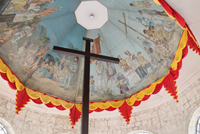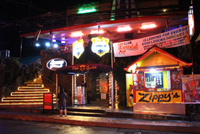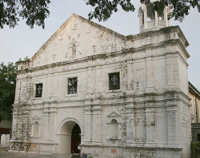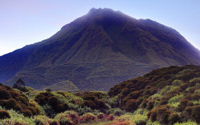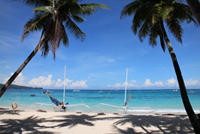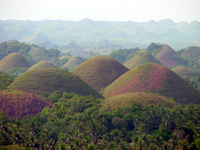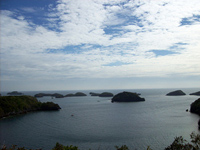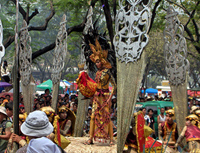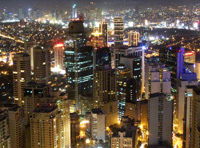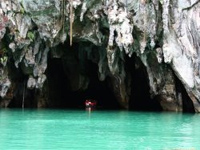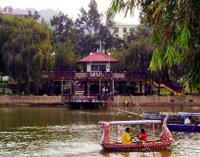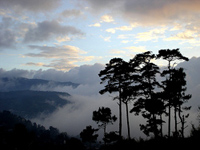Language in the Philippines
Worried about being understood or not being able to communicate?
Not to worry most of the people in the Philippines are good with languages
the official ones are English and Tagalog, many tourist areas also have
hotel and restaurant staff that also speak a wide variety of languages
including Chinese, Korean they will also cheekily tell you that they can
understand American and Australian (depending how strong your accent is)
The people in the Philippines know how to make you smile..!
All else failing they are very good at Charades and age old guessing
game of you wave your arms and point and they guess what you could possibly
want until you all come to and agreement or fall down laughing and go
for a drink.
One thing to note Filipinos are very mellow relaxed people and do not
often raise thier voices and do not expect others to either so however
frustrating it may be be calm relax and keep your cool.
Weather in the Philippines
So when should I visit the Philippines when does it rain and more important
when are the sunny times and places to visit?
With a a hot, steamy, equatorial climate you can experience rain any time
of year and because of the geographical size and diversity of the many
many islands take the informnation below as a guide only.
As with many tropical countries around the world it is the prevailing
wind of the season that dictates the weather pattern in the Philippines:
you have the southwest winds the habagat from May to October and the northeast
winds called the amihan which prevails from November to May
As a general guide November to May is the dry season for most of the country
rains start in June peak in July and gradually decrease into October.
However the Eastern Seaboard Eastern Mindanao, Southern Leyte, Eastern
Samar and Southeast Luzon is normally rainy fromDecember to March and
fairly dry for the rest of the year.
While the central Visayas, Bohol, Negros and Cebu islands are nicely
sheltered from the rains and have less pronounced seasons but these areas
can have rain at any time of the year.
How hot does it get?
Temperatures can climb up to as high as 38°C especially in the lowland
areas the temperatures peak in May
How cold does it get?
No worries here it never gets cold (although the locals may not agree
with that) but during January and February the temperature can drop as
low as 20°C (a little cooler in the mountain areas)
Best time to visit Philippines for the weather?
Probably the best time to visit is during the drier winter months of November
to February when conditions are sunny and pleasant and sea breezes keep
the humidity down but any time is a good time to visit the Philippines
you will have fun whatever the weather.
When to visit the Philippines
So what is the best time to visit the Philippines?
Well of course we are going to say anytime, whenever you visit you will
receive a friendly warm welcome but we do understand that various things
will change what your stay is like (it will always be nice)
High season
As far as weather goes January to May usually has the best weather over
most of the country with sunny days and little rain of course this is
the high season with January to March being busy with foreign arrivals
and in April and May many local Filipinos have thier summer holidays,
prices do go up for these periods but 'busy' for the Philippines is still
not crowded (exception being Boracay over New Year) and you will always
be able to find a pleasant patch of beach to sunbathe swim and sip a cocktail.
Low season
June to September is considered the low season while it can rain all over
the country at this time of year some places get very little rain even
at this time of year. Shop around for accommodation bargains at this time
of year.
Super Peak seasons
Holy Week ( Easter), when hotels book out many months in advance and prices
go through the roof.
New Year’s (Traditional Dec 31st and Chinese New year) also gets
vert busy in some of the top tourist holiday spots but what can beat a
New years party on a white sandy beach with fire dancers live music and
a happy friendly celebrating crowd?
Special festival dates - these vary in different parts of the country
and are usually only a day or two long but worth noting as often shops
close on these days.
Travel safe in the Philippines
Ok so I am going to visit the Philippines but is it safe? can i drink
the water? how is health care if i get ill? are the people friendly? what
are the common scams to look out for?
Relax and read on, as always be sensible we know you're on holiday or
visiting a new place but if you wouldnt do it at home do you really need
to do it here?
The good news is that Filipinos are a very relaxed friendly bunch of people,
of course there is always that element that do not look out for your best
interest but you find these people all over the world (anybody any ideas
on how we can change that?)
The 24-hour emergency number throughout the Philippines is 117.
Dangers and annoyances
The biggest dangers and annoyances are pick pocketing in crowded markets
and on local transport, theft of items left on the beach while you go
for a swim and a wide range of scams and rip-offs that can catch out unwary
travellers. Remember if its too good to be true it usually is, and whatever
the culture nobody just randomnly invites you down a dark alley / to thier
home or to a secluded beach to show you how nice they are!
Although less now an invitation to share food or a drink (often from
an attractive lady to a single guy - we guys a re gullable to attractive
women.. but men use this trick as well under the guise as welcome to the
friendly Philippines) and the food/drink is drugged and you get robbed
as I mentioned above people are normally friendly to complete strangers
for a reason and not always for your own good, golden rule never eat/drink
anything if you dont know where it came from, I ask you if a complete
stranger approached you on the street in your country and offered you
free food and drink would you just take it? (Maybe when I was young an
stupid I would have aah to be young again).
Moneychangers are the other ones to watch nowadays you can go to an official
bank and change cash or use a Cash machine but in some places you may
end up using a money changer NEVER CHANGE MONEY WITH ANYONE ON THE STREET
in all areas there is always a kiosk with rates posted and a teller behind
a counter these are normally ok but watch for slight of hand as they count
out the cash, however busy and rude it seems when you recieve your cash
stay at the window and count it carefully yourself, dont leave until you
are happy !
As with any transaction if the person you are dealing with seems in a
hurry to get the deal done be cautious slow down and take your time rather
walk away and go somewhere else, in general nothign gets done in much
of a hurry in the Philippines so someone hurrying us a red flag!
In Manila some areas have a street child/beggar problem, the traffic
is hectic, crowdds are everywhere and combined with pollution and heat
that never seems to dissapate make sure you escape Manila as soon as you
can!
If you are spending time in Manila watch your pockets on the street as
well as in shopping centres and if you go out drinking try to have at
least one responsible adult in the party who can herd everyone safely
home at the end of the day as my Grandma used to say "drinks in wits
out"
How much to pay?
The biggest thing you will suffer from is inflated prices this can be
a big problem particuarly in Manila where the policy sometimes seems to
be "mmm how much do you think this person will pay for this?"
have an idea of what items should cost before buying from street vendors/bars
etc (go into a local 7 to 11 supermarket and price the basics you will
be buying like soft drinks, beers, food items etc) of course the price
will vary depending on location and demand but you need an idea of what
things should be in the local currency.
Taxi Scams
Taxis are also one to watch for overpricing there is two types of taxi
the metred kind pick up fare is Php40 (Nov 2013) and the metre runs from
there depending on a combination on speed time and distance, a common
practice is for the driver to "forget" to start the metre which
he then makes up the price on arrival - it will always be more expensive
- NO taxi driver "forgets" to set the meter, always check the
meter when you get in the taxi and that it is reset to Php40, if there
is no meter or they will not start it just get out and find another taxi.
All metered taxis are clearly marked do not get into an unmarked vehicle
because someone says it is a taxi (usual excuses are its a new taxi, just
waiting for my plates etc) not marked dont use it.
The other taxi is a fixed price taxi these operate from busy terminals
such as airports and bus stations and give you a fixed price on how much
it will be to your chosen destination, this method will always be a little
more expensive but you will know exactly how much the trip will be! This
is a good way to travel if you are arriving late at an airport and metered
taxis may be scarce.
Drugs - the illegal kind
Drug laws in the Philippines are very strict and the police are enthusiastic
about catching offenders.
You will get no special treatment as a visitor if caught with hard or
recreational drugs and there are plenty sting operations trying to lure
people in so beware.
Carrying 500 grams or more of marijuana is deemed to be trafficking and
carries the death penalty, while a lesser amount will usually result in
a prison sentence. Do not do it and remember do not take packages on planes
/ ferries for anybody else unless you have seen exactly what is inside.
(and its legal). Never take anything on a plane that is not yours and
packed by you.
Health
There is nothing to scary to catch in the Philippines that isnt the same
as all around the world, health care hospitals doctors and dentists are
not the best in the world but there is services if you need them, but
you will have to pay for them all so make sure you are covered by suitable
insurance (for legal reasons we are not allowed to recommend particular
insurance companies sorry) but we can say that make sure any insurance
you take out covers repatriation - ie sending you home in an emergency
it is very expensive to be flown home after a serious illness/accident
it is on the first or private flight with Doctor/nurse in attendance so
make sure any insurance covers this unfortunate possibility, insurance
is one of those things it seem a waste of money until you need it and
we all sincerley hope you never need it!
For people coming to dive in the Philippines we can happily recommend
DAN (divers alert network) insurance this is specialist insurance for
diving related accidents NOT travel insurance.
General health staying healthy
Usually when you travel you are taking your body from its normal routine
food and day to day patterns so expect your body to be a hit more sensitive
to the difference in weather / water / food etc, I would recommend only
drinking bottled water throughout the Philippines not that the water is
not safe but the treatment of the water is different in every country
often it is perfectly healthy water that can give you a mild tummy upset
its the treatment chemicals that are different to what you have at home
that your tummy needs to adjust to, same with food, the chances are you
are enjoying some new and different food that we love in the Philippines,
but it won't be what you normally eat so let your stomach adjust slowly
to the new spices and flavours, and remember especially when you first
arrive drink plenty to keep hydrated and i mean water and juices not all
beer (altough there is a particuarly fine light beer called San Miguel
that is perfect for any time of day).
A handy tip for anyone who has an unsettled tummy is to drink a couple
of flat cokes (shake them first gently open and let the fizz die down)
the sugar and salt along with the water content stuffed into coke is excellent
at settling uncomfortable tummies and keeps you hydrated, also drink as
much water as you can.
If you have a severe stomach and succomb to Traveller's diarrhoea dont
ignore it and try and carry on as normal if you do it will bug you for
the whole trip.
Nearly half of all travellers worldwide will get traveller's diarrhoea
it is partly the adjustment and there are so many ways to pick up a bacteria
infection that you havent been exposed to before, make sure you keep well
hydrated and if it is mild it will pass quickly if it is severe the good
news that being a bacterial infection it responds well to antibiotics
which are available over the counter in the Philippines. Antibiotics such
as Norfloxacin, Ciprofloxacin or Azithromycin will kill the bacteria quickly.
If you are unsure or the antibiotics do not help find a Doctor and get
checked. remember antibiotics only work properly if you complete the entire
course.
Medication
If you need specialist medication for anything take it with you also get
a letter from your doctor specifying your condition and why you need it,
this may be needed at airports and customs channels.
General medication is available easily throughout the Philippines but
remember they will be different brands to what you have at home so if
you have a headache tablet that works for you at home take a few with
you.
Items like plasters bandages antiseptic etc are readily available, always
best to pack a couple of plasters from home in case of small cuts etc
though.
Suncream is available as are plenty types of skin cream - you should
see the local girls plaster thier delicate skin before heading out, but
as with all creams different skins react differently to different creams
so I recommend you bring suncream and skin cream that you have tested
on yourself at home to make sure you have no allergic reactions.
Internet and Mobile Phone connections in the Philippines
It seems much of the world is now connected via a mobile phone facebook
or email nowadays so how will you be able to cope in the Philippines?
Great news the Philippines is a well connected country, internet is widely
available and pretty much the whole country has mobile phone coverage.
Internet
The internet service in all the main areas including all tourist and business
hotspots is excellent, nearly all the places to stay have wireless internet
free of charge of varying speed but not normally too slow (just don't
expect tp downlaod movies) but for email, updating facebook and sending
photos of you on the beach to the office it is more than adequate.
It is normally as easy as enabling your device to search for networks
then clicking connect when it finds one, if a password is needed the establishment
you area eating at/staying at will give it to you.
BE AWARE These networks are not secure do not use them to log onto your
bank or any other sensitive places where you need to enter pin codes passwords
etc.
If you do not have an internet device most tourist places and all cities
have internet cafes where you can send news home etc. its fairly cheap
and you pay by the hour.
Mobile Phone Network
As I mentioned above network coverage is excellent and there area several
mobile providers, you can put your own cell on roaming (often this must
be activated or authorised before you leave home BE AWARE charges for
roaming can be very expensive normally you pay the double the normal phone
tarrif (no free minutes apply to roaming) PLUS a local carrier charge.
So convenient but expensive.
Much cheaper is to by a local sim card Php 50 (Nov 2013) networks are
Smart Communications, Globe Telecom, Talk ’N Text and Sun Cellular
put your new sim card into your phone and you now have a local pay as
you go number just like that no registration or wating its just plug and
play, airtime can be bought and loaded easily at plenty of places.
.Note some of the new phones coming out that are bundled with a network
in your own country may need to be “unlocked” to use a foreign
SIM card (this can be done at local electronics shops)
Electricity in the Philippines
Don't pack the candles and batteries for the torch we should be able
to illuminate your trip to most places across the Philippines some exceptions
are romantic powerless getaways where you want it it getb dark as soon
as possible......
Most of the country runs on 220 volts (similar to Australia, Europe and
most of Asia), although you may come across 110 volts in some rural areas
but most cell-phones, cameras, MP3 players and laptops are dual voltage.
High powered items could cause a problem if it is only 110 volt (don't
pack the microwave) for the ladies (and some gents) hairdryers also dont
work on 110. You have to wander quite a way off the main routes to encounter
this though.
Plugs are the same as the US and Canada with two flat, rectangular pins.
In main tourist centres shops often carry adaptors for sale but best to
bring one with you.
Brown outs
These are area wide power outages (called brownouts because the fuse at
the area substation that overloads is brown (maybe due to fire damage
because of the overload??) They happen when an area is growing quicker
than the local electricity grid is being updated and there is too many
people draining on the power grid (I told you not to pack the microwave)
the cables and substations are being constantly updated across the country,
most of the cities no longer have many of these, although they still do
happen on occasion, in the more rural areas and on some of the small islands
they can occur more commonly, normally the power is only off for a short
time (5 minutes to and hour) then back to normal.
This can cause power fluctuations so be careful using a laptop if the
power is dipping a strong surge can fry a laptops computer chip (not repairable)
if possible pack an AVR automatic voltage regulator in some contries you
can by a replacement laptop cable that incoorperates a power surge protector
well worth it if you intend to use a laptop.
Time zone of the Philippines
The Philippines is eight hours ahead of Universal Time (GMT) all year.
On a more general note about Philippines time keeping most people do
not hurry in the Philippines if you make an arrangement to meet someone
at a certain time dont expect them to be there at that exact time, its
flexible they will turn up when thier ready, traffic allowing etc, relax
and enjoy another drink while you wait.
However if you make an appointment with a government office / official
do turn up on time yourself (even though they probably wont).
The cost of things in the Philippines
While it is impossible to keep this section completely up to date we
can give you a guide as to what to expect when you visit, bear in mind
during the main tourist seasons and holidays prices go up dramatically
accommodation, activities and food. and transport gets more difficult
no cheap flight seats etc, on the other hand if you can travel in between
to main seasons you can really pick up some great bargains, hotle offer
free nights, long stay discounts, free transfers, extra meals and the
such.
As usual big cities like Manila, Cebu etc are more expensive than the
rural towns while popular Islands can vary from cheap in the low season
to expensive in peak season there is also a super peak season..!
Accommodation
Rooms in the Philippines are normally sold on a per room basis so same
price for one or two people. No discounts for single rooms and no extra
for two people.
Luxury Accommodation
On the top end you can pay as much as anywhere in the world for a hotel
if you want and get all the bells and whistles included plus service in
the Philippines is better than many countires and there area hotels in
all the main areas catering for this market.
Price Guide from Php 6000 per room and upwards
Mid Range Accommodation
The bulk of places to stay in the Philippines fall in this broad range
with hotels, guesthouses and bed and breakfasts all being options in this
range
Price Guide starting from Php 2000 per room and upwards
Budget Accommodation
If you really need to keep the budget down to a minimum there are still
plenty budget basic places to stay although in tourist hotspots and during
high season you may not find anything in this price range often they will
not have hot water and very unlikely to have aircon and can be in noisey
locations
Price Guide starting from Php 1000 per room
Food costs
If you are happy to eat local both in food style and local food restaurants
then you can eat well on quite a small budget, finding these places can
sometimes be the problem, as you are visiting often on holiday you are
going to a touristy area so all the tourist style restaurants occupy the
obvious locations, if you want to find the local eating spots you need
inside knowledge, be nice to the reception staff wherer you stay and get
the inside scoop from them, they may be reluctant to tell you because
they dont think you would possibly eat there but persist and you will
find some incredible little shacks and eateries in the most unusual places
you will also make some great new friends.
Price Guide per person for a main course no drinks:
Local food shacks Php 100 - Basic local restaurant Php 150 - simple tourist
style restaurant Php 300 Tourist area restaurant Php 500 Posh restaurant
as much as you will pay...!
Eat up and enjoy Philippines food and drink
While it is true that the food in the Philippines is not held in the
same high regard as nearby Thailand eating is very important in the Philippines
(as it is too me everywhere) while the national signature dish is adobo
a richly marinated pork or chicken with plenty rice there is a lot of
options for eating here it has taken a little from all the neighbouring
countires, been influenced by various countries that have passed through
during thier history and melded and fused them all together with whatever
is available locally and produced a grand varierty of choices for meals.
Of course being surrounded by water seafood is widely available almost
everywhere with various fish cooked in numerous ways a mainstay for many
people.
The main foods are based around pork chicken or fish served with rice
or noodles vegetables are rare you may get some mixed into a meal but
dont expect portions of carrots and potatoes! Also dont expect much beef
and when you do it will be very expensive.
Noodles (pancit) are frequently used in Filipino cooking and come in
various forms. Pancit canton is ribbon-like, stir-fried rice noodles,
while sotanghon refers to thin, vermicelli-like rice noodles.
If you are happy to eat local both in food style and local food restaurants
then you can eat well on quite a small budget, finding these places can
sometimes be the problem, as you are visiting often on holiday you are
going to a touristy area so all the tourist style restaurants occupy the
obvious locations, if you want to find the local eating spots you need
inside knowledge, be nice to the reception staff wherer you stay and get
the inside scoop from them, they may be reluctant to tell you because
they dont think you would possibly eat there but persist and you will
find some incredible little shacks and eateries in the most unusual places
you will also make some great new friends.
Price Guide per person for a main course no drinks:
Local food shacks Php 100 - Basic local restaurant Php 150 - simple tourist
style restaurant Php 300 Tourist area restaurant Php 500 Posh restaurant
as much as you will pay...!
Fast food
Of course you will find a fast food place in every major town look for
the McDonald’s but tgry out the Philippines own chains for great
fast food these include one of my favourites Jollibees similar to McDonald’s
but with a local twist there is also Chowking, Mang Inasal and Max’s
(for fried chicken) throughout the country also you will find various
piazza places and food courts in malls or markets serving Filipino, Japanese,
Chinese, Thai and Korean food.
Drinking
Bottled water P20 - 30 is widely available even from the smallest store
and quite cheap
Fizzy pop P25 - 150 (depending if you buy it in a store or at a posh restaurant)
coke and the like is also easily available
Alcohol P50 - 200 San Miguel is the dominant beer a local pilsner established
in 1890 it is a light lager and comes in standard, light and they produce
Red Horse Extra Strong lager, only a few foreign beers are available notably
Heineken, Budweiser and Japanese brands.
Wine is still very rare in the Philippines some restaurants will stock
australian wines but it will be quite pricey.
|
 Look for places to stay in the Philippines
Look for places to stay in the Philippines